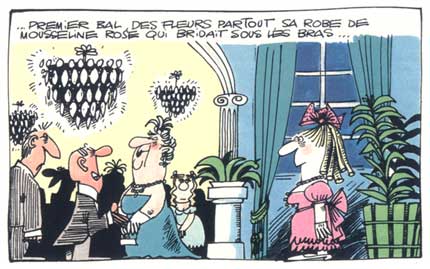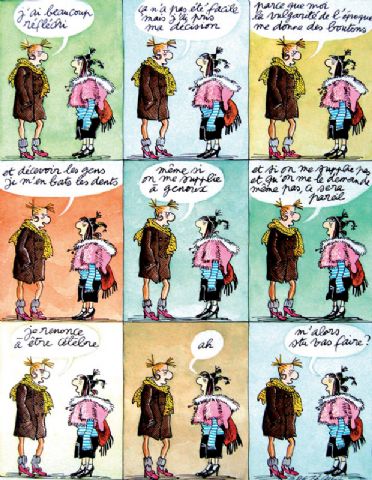Monthly Archives: September 2011
Comic Book Classics # 17
Clare Bretecher
The combination of humour and the mundane melodrama of real life is a familiar theme in comic books. It is present in some of the great narrative moments of the genre; the more wistful episodes of Love and Rockets, the bad-tempered satires of Harvey Pekar and many others I could trot out for you to show off. One of the most charming in this respect is the work of French artist Clare Bretecher (1940 – ).
Bretecher’s gift is to be able to encapsulate the anxieties and absurdity of modern life in her comics. Her observations of women, particularly with regards to their role in (a still surprisingly sexist) French society, are barbed, witty and insightful. Her heroines (if that’s the right word) are distinguished by their ordinariness. In short, Bretecher writes and illustrates how real women engage with life (not beautiful girls, Kerry Bradshaw-style journo wits or any other guff), with badly paid jobs, stroppy teenagers, average-to-dull relationships, unemployment… all the stuff that real people go through every day.
She began her career when Rene Goscinny (of Asterix fame) engaged her to work Facteur Rhesus in 1963. She became an artist for a number of comics and Bds, including Spirou magazine. In the 1970s she joined up with fellow artists Gottlieb and Mandynka in founding the magazine L’Echo des Savanes. It pioneered the genre of humour-based comic-book magazines aimed at adults and soon became one of the most influential comic-book publications in France (Gottlieb would go on to start up the most important contemporary magazine in this genre, Fluide Glacial).
In L’echo Des Savanes she began to publish her first episodes of Les Frustrés; a tale of urban sophisticates and their absurd lives and obsessions. It is popular series to to this day and is collected in a number of BD anthologies.
Her most famous creation, however, is the stroppy, baggy-clothed teenager Agrippine. Bretecher captures her in a variety of moods; as she is angry or reflective but also when she is feeling vulnerable, melancholic or happy. Her concerns are the commonplace of her age group; boys, friends, school, fears for the future, clothes and what people might think. The unfussy, unpretentious style of artwork adds to the charm of Agrippine without taking away the truth and honesty it conveys. I feel I have known girls like Agrippine in real life, something I can’t say about many comic-book characters.
A final thought here about the lettering used by Bretecher. She writes the text in the speech balloons using her own spidery, joined-up French longhand. This makes it difficult to read sometimes, particularly in long speeches, but it contributes enormously to the mood. The speech balloons mirror the minds of the characters speaking; twisting, slightly opaque and at times a bit loopy. I love it. Pick up a copy today.



